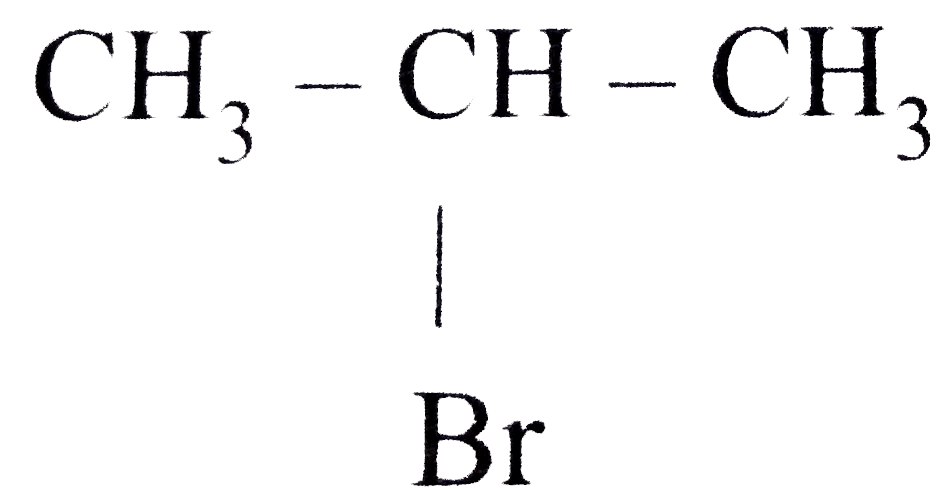Identify the set of reagents/ reaction condition ‘X’ and ‘Y’ in the following set of transformations :
X= dilute aqueous NaOH ,
X=concentrated alcholic NaOH ,
X=dilute aqueous NaOH ,
X= concentrated alcholic NaOH,
To solve the problem, we need to identify the reagents or reaction conditions 'X' and 'Y' for the given transformation of the compound CH3−CH2−CH2Br to the final product CH3−CH(Br)−CH=CH3.
Step 1: Identify the initial compound and the transformation
The initial compound is CH3−CH2−CH2Br, which is a bromoalkane. The final product is CH3−CH(Br)−CH=CH3, which is a bromoalkene. The transformation involves the loss of a bromine atom and the formation of a double bond.
Step 2: Determine the first reaction condition 'X'
To convert the bromoalkane to an alkene, we can use a reaction called dehydrohalogenation. This reaction typically requires a strong base to remove both a hydrogen atom and the bromine atom, resulting in the formation of a double bond.
- Reagents for X: We can use alcoholic KOH or NaOH at elevated temperatures (around 80°C) to facilitate this reaction. Therefore, the first reaction condition 'X' is:
- X = Alcoholic KOH or NaOH at 80°C
Step 3: Determine the second reaction condition 'Y'
After the formation of the alkene, we need to add bromine across the double bond. According to Markovnikov's rule, the bromine will add to the carbon with the lesser number of hydrogen atoms.
- Reagents for Y: The addition of HBr (hydrobromic acid) to the alkene will yield the final product. This reaction can also be performed in the presence of an acid like acetic acid to stabilize the reaction conditions. Therefore, the second reaction condition 'Y' is:
- Y = HBr (in the presence of acetic acid) at room temperature (20°C)
Final Answer
- X = Alcoholic KOH or NaOH at 80°C
- Y = HBr (in acetic acid) at 20°C
The initial compound is CH3−CH2−CH2Br, which is a bromoalkane. The final product is CH3−CH(Br)−CH=CH3, which is a bromoalkene. The transformation involves the loss of a bromine atom and the formation of a double bond.
To convert the bromoalkane to an alkene, we can use a reaction called dehydrohalogenation. This reaction typically requires a strong base to remove both a hydrogen atom and the bromine atom, resulting in the formation of a double bond.
- X = Alcoholic KOH or NaOH at 80°C
After the formation of the alkene, we need to add bromine across the double bond. According to Markovnikov's rule, the bromine will add to the carbon with the lesser number of hydrogen atoms.
- Y = HBr (in the presence of acetic acid) at room temperature (20°C)
- X = Alcoholic KOH or NaOH at 80°C
- Y = HBr (in acetic acid) at 20°C
Topper's Solved these Questions
- BOOK - VMC MODULES ENGLISHCHAPTER - HYDROCARBONSEXERCISE - JEE Main Archive46videos
HYDROCARBONS
- BOOK - VMC MODULES ENGLISHCHAPTER - HALOALKANES AND HALOARENESEXERCISE - IN-CHAPTER EXERCISE - F6videos
HALOALKANES AND HALOARENES
- BOOK - VMC MODULES ENGLISHCHAPTER - ICONIC EQUILIBRIUMEXERCISE - IMPECCABLE50videos
ICONIC EQUILIBRIUM
Similar Questions
Knowledge Check
- Question 1 - Select One
What is compound Z ?
CH3CH2CH2BrNaCN−−−→XH3O+−−−→HeatYCH3CH2OH−−−−−−−→H+ZACH3CH=ChO∣∣COHBCH3CH2CH2CH=NOCH2CH3CCH3CH2CH2CH(OCH2CH3)2DCH3CH2CH2O∣∣COCH2CH3 - Question 2 - Select One
The reaction CH2=CH−CH3+HBr→CH3−Br∣CHCH3 is
Anucleophilic additionBfree radical additionCelectrophilic additionDelectrophilic substitution
Which would undergo SN1 reaction faster in the following pair :
CH3−CH2−CH2−BrandCH3−C∣BrH−CH3View SolutionCH3CH2−CH2−COOHRed P+Br2−−−−−−−→CH3−CH2−CH∣Br−COOH
This reaction is calledView SolutionGive the common names of the following alcohols :
CH3CH2CH3∣CH−CH3∣C∣CH3−CH2OHView SolutionThe major product of the following reaction is:
CH3−CH3∣C∣H−CHCH3∣BrCH3OH−−−−→View SolutionIdentify A, B and C in the following reactions.
CH3CH(CH3)CONH2Br2,NaOH−−−−−−→AHONO−−−→Br2BO−−→CView SolutionIdentify the product in the following reactions.
CH3COOH + NaOH →View Solution

